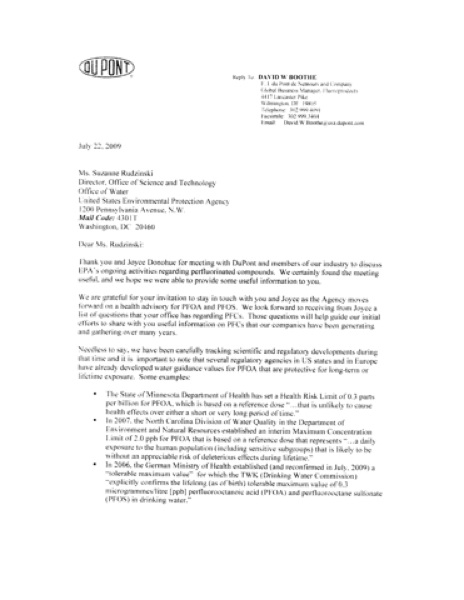
Dupont's Chambers Works facility in Deepwater NJ has poisoned nearby groundwater and drinking water
Not surprisingly, Dupont is pressuring EPA scientist who are developing federal drinking water standards for PFOA.
Dupont specifically targets the work of NJ DEP in setting a low 0.04 ppb guidance value as it proceeds to develop a State drinking water standard (MCL).
Dupont also appears to threaten to renege on their commitment and meet their legal obligations to develop less toxic alternative chemical substitutes if EPA takes tough regulatory action against PFOA.
 Due to a lack of disclosure of these kinds of political lobbying efforts by Dupont, the public and independent scientists have no effective way of knowing about or rebutting these behind the scenes interventions.
Due to a lack of disclosure of these kinds of political lobbying efforts by Dupont, the public and independent scientists have no effective way of knowing about or rebutting these behind the scenes interventions.
So, to promote transparency that is vital to science and public policy, here is Dupont’s intervention:

These numbers (and others we can discuss) are clearly intended to be protective of long-term exposure and are in line with EPA’s existing Provisional Health Advisory of O.4 ppb. In fact our review of these long-term protective values shows them to range from 0.3 to 2.0 ppb, with the exception of a Preliminary Guidance Level of 0.04 ppb from the State of New Jersey designed to inform monitoring of the state’s public water supply while a permanent MCL is being set.
We also want to work in a transparent manner with you and the various offices in the Agency with interests in PFOA and other perfluorinated compounds. We have worked diligently, for example, with OPPTS to develop and implement the 2010/15 PFOA Stewardship Program. That stewardship program has been extraordinarily successful, resulting in significant reductions of PFOA emissions and product content since it began in 2006.
The Program is also driving an important industry transition to replace PFOA or products that may contain PFOA, its potential precursors and higher homologues with shorter chain and other types of perfluorinated alternatives that are less biopersistent and lower in human and environmental toxicity. The Agency reports that over 100 alternative compounds are already being evaluated via the TSCA PMN/consent order process toward this end.
Our research and the data required by OPPTS under TSCA shows that the various types of perfluorinated compounds are very different in physical, toxicological and environmental properties. These pronounced differences make it necessary to consider these compounds individually when addressing the regulatory aspects of the transition and OPPTS has done an excellent job of recognizing those differences as it manages the transition. We believe this same differentiation is important when determining water standards as well. Efforts designed to manage PFC’s in water without rcgard to these differences and to the benefits of switching to shorter chain homologues and other alternatives could have unintended negative effects on a successful transition under the Stewardship Program.
We pledge to work diligently vvith you as you seek to follow up on OST’s development of a provisional health advisory. Through frequent communication and with a genuine desire on both sides to ensure the application of the best available science, we believe that we can help the Agency achieve its mission of protecting public health and the environment.
Sincerely,
David W. Boothe .
Dupont FluoroproductsCCÂ Â Â Â Â Â Â Â Â Â Â Â Â Â Edward Ohanian- US EPA, Office of Water
Joyce Donohue – US EPA, Office of Water


Pingback: WolfeNotes.com » Jackson’s Back in Jersey – for a Pony in Pompton Lakes
Pingback: WolfeNotes.com » Dupont’s Tentacles Extend into North Carolina Science
Pingback: WolfeNotes.com » Dupont Fined for Coverup of Chemical Health Risks